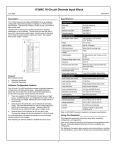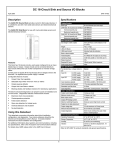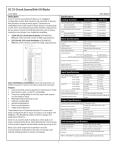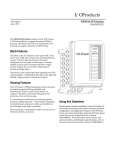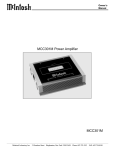Download Genius RTD Input Blocks datasheet, GFK-0053C
Transcript
This Datasheet for the IC660BBA021 Block 24/48Vdc RTD Input 6 Channels. http://www.cimtecautomation.com/parts/p-14417-ic660bba021.aspx Provides the wiring diagrams and installation guidelines for this GE Series 90-30 module. For further information, please contact Cimtec Technical Support at 1-866-599-6507 [email protected] RTD Input Blocks June 2002 GFK-0053C Description _________________________________ Specifications _________________________________ RTD Input blocks monitor temperature inputs from Resistive Temperature Detectors (RTDs). Two RTD blocks are available: Catalog Numbers 115 VAC/125 VDC RTD Block Terminal Assembly Electronics Assembly IC66*BBA101 IC66*TBA101 IC66*EBA101 24/48 VDC RTD Block Terminal Assembly Electronics Assembly C66*BBA021 IC66*TBA021 IC66*EBA021 15 VAC/125 VDC RTD Block (IC66*BBA101) 24/48 VDC RTD Block (IC66*BBA021) They are identical except for the power supply. Block Specifications Size (height x width x depth) RTD Input (115VAC/125VDC .1A Max) Weight 4 lbs. (1.8 kg) LEDs (I/O Block) Unit OK, I/O Enabled Block to Block Isolation 1500V Group to Group Isolation 300V Heat Dissipation 7W maximum Block Power 115VAC Power supply voltage (@ 7W) 93-132 VAC 105-145 VDC 18-56 VDC 10% 47-63 Hz 10% max. ripple max. ripple Power supply dropout time 1 cycle Features Input Specifications An RTD Input block has six input circuits, in three groups of two circuits each. Group to group isolation is 300 volts. Each input can be used with platinum, nickel, or copper RTDs. Input data for each circuit is linearized according to the type of RTD selected. Input data is reported to the CPU in engineering units of tenths of degrees Celsius, tenths of degrees Fahrenheit, tenths of Ohms, or counts. Additional configurable features include: Input resolution 8.83” (22.44cm) x 3.34” (8.48cm) x 3.91” (9.93cm) 125VDC 10ms 24/48VDC 10ms 0.1° C Absolute accuracy (at 25°C)* Platinum or Nickel +/-0.5 °C typical, +/-1.0°C maximum 10W Copper: +/-5°C typical, +/-10°C maximum Input update frequency Once every 400ms, 800ms, or 1600ms Input filter ranges (per block) 400ms, 800ms, 1600ms Alarm thresholds RTD resistance Alpha type Linearization Input filter time RTD blocks are factory-calibrated; there is no need for subsequent recalibration. In addition, the block’s automatic diagnostics can pinpoint the cause of installation and run-time errors: RTD linearization Platinum (DIN 43760), Nickel (DIN 43760), Copper, Linear Resistance measurement range 0 to 5000 Ohms Diagnostics Input shorted, Internal fault, Wiring error, Open wire, Overrange, Underrange, High Alarm, Low Alarm Input Short detection Internal Fault detection Wiring Error detection Open Wire detection Overrange and Underrange input indication High and Low input alarms Fault reporting can be enabled or disabled circuit-by-circuit. Refer to GFK-0867 for product standards and general specifications. *In the presence of severe RF interference (IEC 801-3, 10 V/m), accuracy may be degraded to +/- (0.5% of full scale reading, plus 0.5% of reading). Using this Datasheet _________________________ For an IC697 series PLC, the CPU may be rel. 1 (IC697CPU731 or 771) or later. The bus controller may be rel. 1 (IC697BEM731) or later. Compatibility _________________________________ Hand-held Monitor IC66*HHM501D, version 3.5 (or later) is required. This datasheet summarizes information about block installation, configuration, and diagnostics. For an IC600 series PLC, the CPU must be rev. 105 or later. For a IC600 series Plus PLC, rev. 110 or later is required. The programming software must be Logicmaster™ 6 rel. 4.02 or later. Your primary reference should be the Discrete and Analog Blocks User’s Manual. It includes detailed instructions for block installation and configuration. For an IC550 series PLC, the CPU must be rev. 3.0 or later. The programming software must be rel. 2.01 or later. For additional information about systems and communications, including bus specifications, refer to the I/O System and Communications Manual. 1 RTD Input Blocks June 2002 GFK-0053C If the block is at either end of the bus, connect a terminating resistor of the appropriate type (see the System and Communications User’s Manual for details) across its Serial 1 and Serial 2 terminals. Installation Instructions _______________________ Carefully inspect all shipping containers for damage. If any equipment is damaged, notify the delivery service immediately. Save the damaged shipping container for inspection by the delivery service. After unpacking the equipment, record all serial numbers. Save the shipping containers and packing material in case it is necessary to transport or ship any part of the system. Start of Bus Field Wiring _________________________________ The block can be mounted right side up, or upside down. Leave at least 2 inches of space between blocks. Mount the block by drilling two screw or bolt holes for 8-32 hardware. Position the block so that the notches in the upper and lower flanges line up with the mounting holes. Mount the block using 8-32 screws. Use star washers to provide ground integrity. Terminals 5 to 32 are for field devices. They take a single wire up to AWG #14 (avg 2.1mm2 in cross-section). Minimum recommended size is AWG #20 (avg .54mm2 in cross-section). Wiring for Block Power For block power, connect the power source to terminals 6 and 7. For an AC block, connect the AC source to the HOT terminal and neutral to the NEUT terminal. For a DC block, connect the DC source to the DC+ terminal and the return to the DC- terminal. Grounding The block’s mounting screws must not be used as the only means of grounding the block. Connect the green ground screw on the block to a reliable ground system using a short wire lead, minimum size AWG #12 (avg 3.3mm2 in cross-section). The ground (GND) terminal (5) is for block safety. It is connected to the block chassis. Warning Wiring for Input Devices If mounting screws do not make good ground connection and the ground screw is not connected to a reliable ground, the block is not grounded. Electrical shock hazard exists. Death or personal injury may result. There are 4 terminals available for each input device: a SIG, RTN, REF, and SHLD input. Connect RTDs between the SIG and RTN terminals. The REF input is used for lead wire compensation of a 3-wire RTD. For a 3-wire RTD, connect the third wire to the REF terminal. For 2-wire RTDs, short the REF terminal to the RTN terminal. Block Wiring ________________________________ Do not overtorque the terminal screws. Recommended torque for all terminals is 6 in/lb (.678 N/M). Serial Bus Wiring Power Terminals 1 to 4 are for the serial bus. These terminals accept one AWG #12 wire (avg 3.3mm2 cross-section) or two AWG #14 wires (each avg 2.1mm2 in cross-section). The minimum recommended wire size is AWG #22 (avg .36mm2 in cross-section). 2-WIRE RTD Terminals 1 - 4 can also accommodate spade or ring terminals up to 0.27 inch (6.85mm) wide with a minimum opening for a #6 screw, and up to 0.20 inch (5.1mm) depth from the screw center to the back barrier. Be sure unshielded wire ends are not longer than 2 inches (5 cm). 3-WIRE RTD Using one of the cable types recommended in the System and Communications User’s Manual, connect the serial bus to terminals 1- 4. 2-WIRE RTD 3-WIRE RTD SERIAL 2 SHIELD IN 4 SHIELD OUT RED BLK BLK SHLD 5 6 7 8 9 10 11 12 13 14 15 16 17 18 19 20 21 22 23 24 25 26 27 28 29 30 31 32 SERIAL 1 3 Serial 1 Serial 2 Shield In Shield Out Serial 1 Serial 2 Shield In Shield Out Genius I/O blocks are considered "open equipment" and therefore must be installed within a protective enclosure. They should be located in an area that is clean and free of airborne contaminants. There should be adequate cooling airflow. 2 Terminating Resistor Terminating Resistor Block Mounting 1 End of Bus GND NC SIG RTN REF SHLD SIG RTN REF SHLD SIG RTN REF SHLD SIG RTN REF SHLD SIG RTN REF Input 1 Input 2 Input 3 Input 4 Input 5 SHLD SIG RTN REF Input 6 SHLD Each circuit also has a SHLD terminal for shield termination, if desired. This terminal is internally connected to the block chassis and to the input power safety ground terminal. 2 RTD Input Blocks June 2002 GFK-0053C Noise Suppression Block Operation ________________________________ If noise spikes exceeding 4000 volts will be present in the system, additional noise suppression is needed to protect the block. For each pair of inputs, a multiplexer switches the A/D converter between the RTD inputs and internal reference resistors that are used for self-calibration. The following diagram shows one pair of inputs. This can be provided by physically separating and shielding the RTD input leads from any noise source. Alternatively, metal oxide varistors can be installed between RTN and GND. Isolated DC Power See the I/O System and Communications Manual and Discrete and Analog Blocks User’s Manual for additional information. Power Transformer Rectifier / Regulator SIG MUX RTD RTN Removing an Electronics Assembly _____________ A/D Converter AMP SVFC Current Source SIG RTN REF Connector Pins Unscrew the retaining screws at the top and bottom of the block. 2. Using a Block Puller (IC660BLM507), engage the tabs in the first vent slots. Move the tool to the center of the block and squeeze the handle. 3. Pull the Electronics Assembly upward. Serial Bus Reference Resistors Opto-couplers isolate the control and clock signals; a small transformer isolates the circuit power. A synchronous voltage-to-frequency converter changes the measured signals to the proportional frequency sent via an opto-coupler to the processor. The processor’s frequency counter converts this synchronous frequency to a 16-bit binary number. Terminal Assembly The processor corrects each input measurement for lead resistance and for internal offset and gain drifts as it converts the input to an ohmic value. This value is either reported as is, or linearized according to the RTD type selected and converted to a value in degrees. The per channel update rate (input filter time) is preset. It may be 400, 800, or 1600 milliseconds. These selections provide 14, 15, or 16 bit resolution of the measurement. LEDs _______________________________________ Warning The block's Unit OK and I/O Enabled LEDs show its operating status: If power is applied to the field terminals, power is also exposed on the connector pins at the base of the Terminal Assembly, and electrical shock hazard exists. Do not touch the connector pins! Death or injury may result. Unit OK Inserting an Electronics Assembly I/O Enabled Meaning ON ON Block functioning, CPU communicating ON OFF Block functioning ON Blinking Block functioning, Circuit forced Blinking ON Circuit fault, CPU communicating Blinking OFF No CPU communications for 3 bus scans Align the Electronics Assembly in the guides and push down firmly. Caution Do not exert excessive force; it may damage the block. 3. Quad Opto Coupler RTD Retaining Screws (Qty. 2) 2. Processor REF Electronics Assembly 1. Input Power Opto Coupler Opto Coupler The block’s Electronics Assembly can be replaced with a compatible model without removing field wiring or reconfiguring the block. 1. Regulator Circuit fault No CPU communications for 3 bus scans If unusual resistance is met, remove the Electronics Assembly. If power is applied to the block, DO NOT TOUCH THE CONNECTOR PINS! Inspect the Terminal Assembly, connector receptacle, and connector edge board (on the Electronics Assembly). Be sure the keying matches. Remove any obstacles and reinsert the Electronics Assembly. Pay close attention to the alignment of the guide pins. Secure the Electronics Assembly with the screws on the top and bottom of the Terminal Assembly. Note: If the Electronics Assembly has been removed from a block for some length of time, contaminants may have built up on the exposed connector pins. After the block is reassembled, these contaminants could affect the accuracy of measurements. When reassembling the block, push the Electronics Assembly in and out a few times to assure a fresh mating surface. 3 Alternate Blinking Circuit fault, Circuit forced Synchronous Blinking No CPU communications - block number conflict OFF No block power, or block faulty OFF RTD Input Blocks June 2002 GFK-0053C Diagnostics _________________________________ Configuration _________________________________ First, the block must be configured with a Hand-held Monitor to: The block’s advanced diagnostics provide the messages listed below. Fault messages can be cleared from the Hand-held Monitor or the CPU. Input Shorted: Input circuit measurement below the minimum expected for RTD type. May indicate a fault in the wiring or in the RTD. Enter its Device Number (serial bus address). Enter its Reference Number (required only for IC600 and IC550 series PLCs only). Note: If a block is configured offline, it must be properly grounded and have a 75 Ohm resistor installed across its Serial 1 and Serial 2 terminals. See the Discrete and Analog I/O Blocks User’s Manual for instructions. The rest of the features can be configured either using a Hand-held Monitor, or by sending a Write Configuration datagram to the block from the host. Internal Fault: One or more of the internal auto-calibration readings for a pair of channels is out of tolerance. The block reports a value of zero for each channel of the faulty pair. The block’s Electronics Assembly should be replaced. Feature Wiring Error: Connections between the RTD and the block’s Terminal Assembly are incorrect. This may cause faulty input data to be reported. Field wiring should be changed to match the wiring diagram indicated on the block’s faceplate. Circuit or Block Factory Setting Selections Device Number Block null 0 to 31 (a number must be selected) Open Wire: Less current than expected for the input type on that circuit. An Open Wire diagnostic may also mean that the input circuit excitation current is not present. The RTD may be missing or faulty, or the RTD is not connected to the block. Reference Address Block none Depends on host CPU type Baud Rate Block 153.6 std Overrange: The Celsius or Fahrenheit input value exceeds expected maximum positive value (limits are 850°C or 1562°F for platinum, 250°C or 482°F for nickel, +3276.7°C or +3276.7°F otherwise). This only occurs when converting to units of temperature. Channel Active Report Faults Circuit Circuit yes yes 153.6 std, 153.6 ext, 76.8, 38.4 Kbd yes, no Linearization Circuit Platinum Platinum, Nickel, Copper, Linear Underrange: The Celsius or Fahrenheit value exceeds expected maximum negative value (limits are -200°C or -328°F for platinum, 60°C or -76°F for nickel, -3276.7°C or -3276.7°F otherwise). RTD Resistance Circuit 100.0 Ohms 5.0 - 2000.0 Ohms Alpha Type Circuit 0.003850 0.00100 - 0.007000 Low Alarm Circuit -200 C -32,767 to +32,767 or 0 to +65,535 High Alarm Circuit +800 C -32,767 to +32,767 or 0 to +65,535 Input Filter Time Block 1600ms 400, 800, 1600ms Units Block Celsius Celsius, Fahrenheit, Ohms, counts Configuration Protection Block disabled enabled, disabled Low Alarm/High Alarm: Individual low and high alarm thresholds can be configured for each input. If an input reaches one of its alarm thresholds, the block reports a Low Alarm or High Alarm diagnostic. The diagnostic is triggered upon reaching the limit and is repeated until circuit faults are cleared. 4 yes/no





